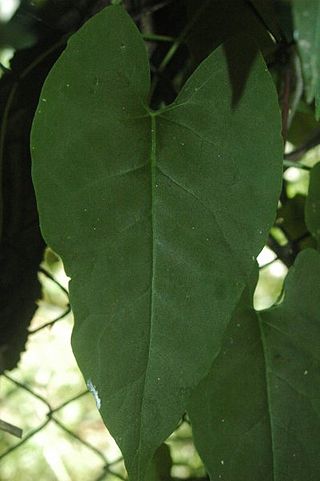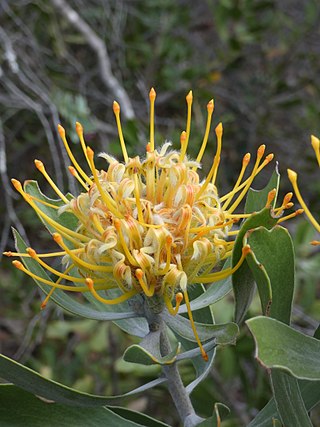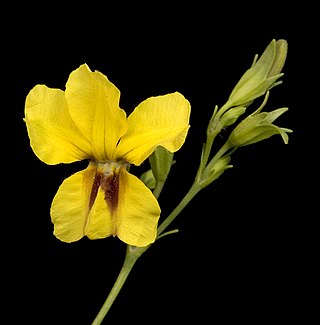
Eucalyptus pauciflora, commonly known as snow gum, cabbage gum or white sally, is a species of tree or mallee that is native to eastern Australia. It has smooth bark, lance-shaped to elliptical leaves, flower buds in clusters of between seven and fifteen, white flowers and cup-shaped, conical or hemispherical fruit. It is widespread and locally common in woodland in cold sites above 700 m (2,300 ft) altitude.

Chlorophytum comosum, usually called spider plant or common spider plant due to its spider-like look, also known as spider ivy, airplane plant, ribbon plant, and hen and chickens, is a species of evergreen perennial flowering plant of the family Asparagaceae. It is native to tropical and Southern Africa but has become naturalized in other parts of the world, including Western Australia and Bangladesh. Chlorophytum comosum is easy to grow as a houseplant because of its resilience, but it can be sensitive to the fluoride in tap water, which commonly gives it "burnt tips". Variegated forms are the most popular.

Salpichroa origanifolia is a species of flowering plant in the nightshade family known by the common names lily of the valley vine, pampas lily-of-the-valley or cock's-eggs.

Ipomoea cairica is a vining, herbaceous, perennial plant with palmate leaves and large, showy white to lavender flowers. A species of morning glory, it has many common names, including mile-a-minute vine, Messina creeper, Cairo morning glory, coast morning glory and railroad creeper. The species name cairica translates to "from Cairo", the city where this species was first collected.

Afrocarpus falcatus is a species of tree in the family Podocarpaceae. It is native to the montane forests of southern Africa, where it is distributed in Malawi, Mozambique, South Africa, and Eswatini. Common names include common yellowwood, bastard yellowwood, outeniqua yellowwood, African pine tree, weeping yew, Afrikaans: outeniekwageelhout, kalander, Sotho: mogôbagôba, Xhosa: umkhoba and Zulu: umsonti. It is widespread, in some areas abundant, and not considered threatened, but it is a protected tree in South Africa. It is grown as an ornamental tree, especially in South Africa, and occasionally abroad.

Reynoutria multiflora is a species of flowering plant in the buckwheat family Polygonaceae native to central and southern China. It is known by the English common names tuber fleeceflower and Chinese (climbing) knotweed. It is known as he shou wu in China and East Asia. Another name for the species is fo-ti, which is a misnomer.

Albuca bracteata, is known by the common names pregnant onion, false sea onion, and sea-onion. It is a species of bulbous flowering plant in the family Asparagaceae. Its flowering stems can reach a height of 90 cm and can carry up to 100 greenish white flowers.

Oxylobium ellipticum, commonly known as the common shaggy-pea, is a flowering plant in the family Fabaceae. It has dense clusters of yellow pea flowers and elliptic-shaped leaves. It grows in south-eastern Australia.

Senna italica, the Port Royal senna, Italian senna, or Senegal senna is a legume tree in the genus Senna. It is recognized by many other common names based on the regions it grows in. In India, it is used to produce a powder for treating hair-related diseases which is known as “neutral henna”. Whereas, in some parts of the world, this species is cultivated for the leaves which yield the drug senna, known commonly as Senna glycoside, which in turn is the base for a laxative. Senegal senna is easily distinguishable through its many distinctive features. There are 3 subspecies of this plant based on the size of the inflorescence and the length of the petiole. The subspecies are italica, micrantha, and arachoides. In many regions, this plant is cultivated commercially and medicinally.

Strophanthus kombe, the kombe arrow poison, is a vine that grows in the tropical regions of Eastern Africa, and is part of the genus Strophanthus, which contains approximately 38 species. S. kombe contains a cardiac glycoside which directly affects the heart. Historically, both the seeds and roots of the plant were used in the preparation of poison arrowheads used for hunting. Today, the seeds are used pharmaceutically for patients with certain heart conditions that affect blood circulation. The seeds are traded primarily with Europe, but have also been exported to the United States and Japan.

Persoonia media is a species of flowering plant in the family Proteaceae and is endemic to eastern Australia. It is an erect to spreading shrub or tree with branchlets and leaves that are glabrous or only sparsely hairy, elliptic to egg-shaped leaves and up to sixteen yellow flowers on a rachis up to 150 mm (5.9 in) long.

Euclea crispa, commonly known as the blue guarri, is an Afrotropical plant species of the family Ebenaceae. The hardy and evergreen plants may form a dense stand of shrubs, or grow to tree size. It is widespread and common in the interior regions of southern Africa, and occurs northward to the tropics. Though some are present near the South African south and east coasts, they generally occur at middle to high altitudes. It is readily recognizable from its much-branched structure and dull bluish foliage colour. Those bearing lanceolate leaves may however resemble the Wild olive, another common species of the interior plateaus.

Fockea multiflora, or python vine, is a plant of the dogbane family, Apocynaceae, native to Tanzania, Mozambique, Zimbabwe, Zambia, Angola, Botswana, Namibia, including the Caprivi Strip, and Malawi. It is a large semisucculent liana, growing to some 15m in length and up to 60 cm in diameter, found primarily in the seasonally dry tropical biome.

Dracaena mannii Baker or small-leaved dragon tree, is a small to medium-sized tree, though recorded up to 30 m tall with stem to 2 m in diameter in Cameroon and Gabon. It occurs from Senegal to Angola along the African west coast, is widespread in tropical Africa and is found along the African east coast from Kenya to Kosi Bay in northern KwaZulu-Natal. It prefers lowland, submontane and montane forests which are either moist and evergreen, swampy or on coastal dunes. It is also found along forest edges, in clearings and on river banks from sea level to 1,800 metres. It is one of some 120 species currently recognised in its genus, which occur primarily in Africa and southern Asia with a single vagrant species in Central America. The species is named after Gustav Mann (1836–1916), a German botanist, who corresponded with John Gilbert Baker.

Leucospermum cuneiforme is an upright evergreen shrub with many pustules growing on the lower branches, wedge-shaped leaves, and oval, initially yellow flower heads that later turn orange, with long styles sticking far beyond the perianths, jointly giving the impression of a pincushion. It is called wart-stemmed pincushion in English and luisiesbos (lice-bush) in Afrikaans. The species is common in the southern mountains of South Africa.

Goodenia macrophylla, or large-leaved velleia, is a species of flowering plant in the family Goodeniaceae, and is endemic to the south-west of Western Australia. It is a glabrous perennial plant with egg-shaped to elliptic leaves with toothed edges, and yellow flowers.

Felicia nordenstamii is a flowering shrub in the family Asteraceae. It is found only in South Africa where it grows on limestone hills close to the sea on the southern coast. Felicia nordenstamii is a many-branched shrub growing up to 30 cm (1 ft) tall. The lower parts of the stems are covered in grayish brown bark and the upper stem has many crowded, upwardly angled, alternate leaves with long hairs on the lower surfaces. Large flower heads form at the tips of the branches, each about 41⁄2 cm across, with about thirty purplish blue ray florets surrounding many yellow disc florets.

Wahlenbergia capensis, commonly known as the Cape bluebell, is a plant in the family Campanulaceae and is native to the Cape Province but has been introduced to Australia. It is an annual herb with up to four greenish blue, bell-shaped flowers with spreading petal lobes.

Nematolepis elliptica, is a small, bushy shrub with white flowers in small clusters from September to November. It is endemic to the south coast of New South Wales.

Montinia is a monotypic genus of flowering plants belonging to the family Montiniaceae. It only contains one known species, Montinia caryophyllaceaThunb.























